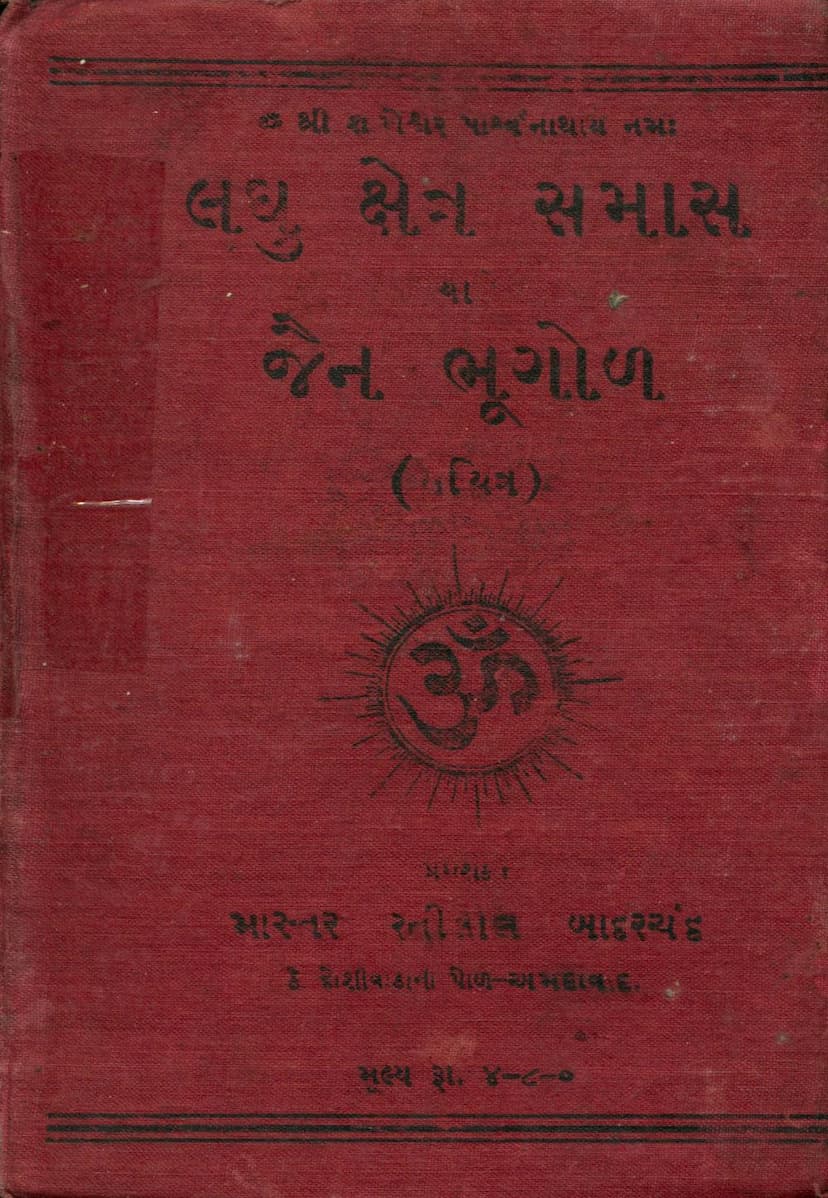Laghu Kshetra Samas Ya Jain Bhugol
Added to library: September 2, 2025

Summary
This document is a publication of "Laghu Kshetra Samas" (also referred to as "Jain Bhugol" or Jain Geography), authored by Acharya Ratnashekharsuri. The publisher is Ratilal Badarchand Shah of Ahmedabad, and it was published in Vikram Samvat 2476 (which corresponds to 1950 CE). The book is presented with detailed explanations, word meanings, and verses (gathas).
Here's a breakdown of the content based on the provided pages:
Key Information:
- Title: Laghu Kshetra Samas (or Jain Bhugol)
- Author: Acharya Ratnashekharsuri
- Publisher: Ratilal Badarchand Shah
- Publication Year: VS 2476 / CE 1950
- Price: Rs. 4-0-0
- Language: Gujarati
Publisher's Statement (Prakashak nu Nivedan):
The publisher expresses immense joy in releasing this work by Acharya Ratnashekharsuri. They acknowledge that other editions of "Kshetra Samas" exist but highlight the deficiencies of those publications:
- An earlier edition by Shravak Bhimsingh Manek is in older language and difficult for children.
- An edition by Shri Jain Dharma Prasarak Sabha is too brief and lacks word meanings.
- An edition by Shri Mukti Kamal Jain Mohan Mala, while useful, is too extensive for current study needs.
This new edition, prepared by Master Mangaldas Mansukhram, aims to be a convenient and accessible text for students. It includes:
- Original verses (mul gatha).
- Word meanings.
- Verse-wise meaning (gatharth).
- Detailed commentary (vivechan), including essential and useful information without being overly lengthy to avoid boredom.
- Explanations are provided where the meaning isn't clear from the verse itself.
- Inclusion of diagrams (yantra), tables (kathao), and illustrations to aid understanding.
Introduction (Prastavana):
The introduction places the book within the framework of Jainism's fourfold Angas (Anuyogs):
- Dravyanuyog: Deals with the description of substances like Dravya and Tattva.
- Ganitanuyog: Primarily focuses on mathematics.
- Charankarananuyog: Describes the conduct and practices of monks and nuns.
- Dharmakathanuyog: Contains religious narratives.
"Laghu Kshetra Samas" is classified under Ganitanuyog due to its significant mathematical content. It's noted that understanding basic arithmetic operations like addition, subtraction, multiplication, and division is necessary for studying this text.
Book Structure:
The book is divided into six sections (Adhikars), with a total of 263 verses (gathas):
- Jambudvipa Adhikara: The largest section (194 gathas). It describes the six regions (kshetras) of Jambudvipa, seven mountain ranges (varshadhar parvat), rivers, continents, earth's surface (jagatī), forest regions, the Jambu tree, cities, etc.
- Lavan Samudra Adhikara: Describes the ocean of salt water (Lavan Samudra), its shape, underwater structures (pātal kalasha), peaks (shikha), growth of peaks, deities of continents and sub-continents, Suryadvipa, Chandradvipa, Gautamdvipa, Antardvipa, etc.
- Dhataki Khand Adhikara: Contains 15 gathas describing the mountains, Jambu tree, regions within Dhataki Khand, and highlights similarities and differences with Jambudvipa.
- Kalodadhi Adhikara: The smallest section with only 2 gathas, as its description is similar to Lavan Samudra.
- Pushkaradvipa Adhikara: Consists of 19 gathas, describing Pushkaradvipa with special emphasis similar to Dhataki Khand.
- Ardha Dvipa Mahara Adhikara: Contains 5 gathas describing Manushyottar mountain, Nandishwar Dvipa, Kundal Dvipa, Rupak Dvipa Jina temples, and Dik-Kumari (celestial maidens).
Author's Information:
Limited historical information is available about Acharya Ratnashekharsuri. His birthplace, parents' names, and place of demise are unknown. However, based on his works like "Laghu Kshsetra Samas," "Shrīpala Charitra" (in Prakrit gathas), "Shrī Gunsthan Kramaroh," "Guru Gun Shattrishika," and "Nishuddhi," it is believed he lived during the 15th century.
General Content:
The text is an astronomical and geographical treatise from a Jain perspective, detailing the structure of the cosmos, particularly the various continents (dvipa), oceans (samudra), mountains, rivers, regions, and celestial bodies within the Jain cosmology. It emphasizes detailed measurements and mathematical calculations for these geographical features. The publication also includes illustrations and diagrams to aid understanding.
Appendices (Parishisht):
- Parishisht-2: This section discusses the current Earth's location within the Jain geographical framework. It tentatively places our current Earth in the southern part of Bharat Kshetra's southern region (Dakshin Bharatardh). It also provides calculations for the dimensions of this region in yojanas and addresses the misconception that America is Mahavideh, refuting it based on Jain cosmological descriptions (e.g., continuous presence of the fifth era, existence of the Sangha).
Mangaḷācaraṇa (Invocation):
The book begins with an invocation to Lord Mahavir Swami and Acharya Ratnashekharsuri's Guru, Vajrasen Suri, seeking blessings for writing the text.
Specific Topics Covered (from Table of Contents excerpts):
- Number of islands and oceans in the three worlds.
- Detailed descriptions of Pralaya Upama (a unit of time/measure).
- Description of Jagati (earth's surface).
- Description of forests on either side of Jagati's platform.
- Origin of deities in Jambudvipa.
- Details of mountains, regions, their heights, widths, and areas.
- Measurements and diagrams for rivers, streams, waterfalls, and associated islands.
- Descriptions of various trees and groves.
- Descriptions of the six eras of time (Aaras) and their characteristics.
- Details of celestial bodies like the moon and sun, their orbits, and distances.
- Mathematical calculations related to Jambudvipa's circumference and area.
- Descriptions of Lavana Samudra, Dhataki Khand, Kalodadhi, Pushkaradvipa, and Ardha Dvipa, including their measurements, inhabitants, and special features.
- Details about the Manushyottara mountain, Nandishwar Dvipa, and other sacred places.
In essence, "Laghu Kshetra Samas" is a foundational Jain text on cosmology and geography, providing a mathematically and geometrically detailed account of the Jain universe, with a particular focus on Jambudvipa and surrounding regions. The 1950 edition is presented as a refined and user-friendly version compared to earlier publications.